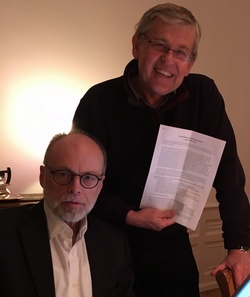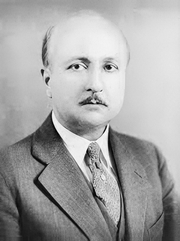Did Andreas Vesalius really die from scurvy on the island of Zakynthos in 1564?
Evidence does not support this theory.
NOTE: The following article authored by Theo Dirix, and Dr. Rudi Coninx, is a rebuttal of Pavlos Plessas' theory that Andreas Vesalius indeed died from scurvy. The original article entitled "Powerful indications that Vesalius died from scurvy" by Pavlos Plessas was presented in a meeting at the island of Zakynthos in 2014.

Dr. Rudi Coninx, and Theo Dirix
Andreas Vesalius, the father of modern anatomy, was a famous man in his time. Born Andries van Wesel in 1514 in Brussels, he became the most important authority on anatomy of his time, daring even to correct the teachings of Galen, the ultimate reference on anatomy since the ancient times. Author of the most famous book on anatomy, the seven-volume "De Humani Corporis Fabrica, Libri Septem" , professor of surgery and anatomy in Padua at age 23 in 1537, imperial physician to the court of King Charles V and personal physician of the emperor of the Spanish Empire, King Philip II, Andreas Vesalius’ accomplishments are multifold. Yet, surprisingly, there are lots of things we do not know about him: how did he look like, for example, but also –and that is the topic of this paper- how did he die, what did he die from, and where exactly is he buried?
There have been more items related to Vesalius’ life that were wrongly transmitted through time, but recent investigations have put to rest a number of “disputed” facts that were erroneously reported and commonly accepted. They often made into the general history books or even into Wikipedia. The two most glaring ones were
1. That Andreas Vesalius had to leave the Imperial Court in Spain because the Inquisition was investigating him for allegedly doing an autopsy on a person that was not yet dead.
• We now know that Andreas Vesalius did not leave the Imperial Court for his pilgrimage to Jerusalem under pressure of the Inquisition, as is often alleged [1], but that he left on his own accord and with the full support of the Emperor who provided him with introduction letters to Spanish embassies abroad. We thought the Vesalius and the inquisition myth was laid to rest in 1928 [2], but has to be refuted again and again to this day, it seems [3].
2. That Andreas Vesalius was shipwrecked, and presumably drowned
• Vesalius did not die shipwrecked, as it was still alleged by Wikipedia recently [4] (but now corrected. His ship arrived safely at the harbour of the island of Venetian owned island of Zante (now Zakinthos, Greece) and Andreas Vesalius went ashore there.
What do we know for sure about the last days of Andreas Vesalius?
• We know that Andreas Vesalius undertook a pilgrimage to Jerusalem in early March 1564, arriving in Venice late April, and that he sailed from Venice via Cyprus to Jerusalem in early May. He only stayed for a short time in Jerusalem, probably one month. He then traveled from Jerusalem through the Sinai desert to Alexandria, Egypt and boarded a Venetian ship there in September 1564, heading for Venice.
• We know that the return journey was eventful. The ship was initially driven off course and then stuck without winds for over forty days which lead to food and water shortages on the ship. Most passengers fell ill, and many died. Their bodies were thrown overboard. This caused great anxiety to Andreas Vesalius who feared being thrown overboard unceremoniously in case he died. Vesalius became ill himself and lay sick in the hold with nobody taking care of him. (Account of Reinert Soleander, quoted by Biesbrouk et al.) [5].
• We also know that he stepped off the ship on the Venetian island of Zante (now Zakynthos in Greece) on October 15, 1564, sick, weak and frail, that he slowly walked towards the gates of the city where he collapsed and fell dead.
These are the facts that can be attested, and are not in dispute. What remains disputed is: did this 50 year old man die from scurvy, as is alleged?
In this article we will look at the arguments advanced in favour of the scurvy theory and see if there is any evidence to support these arguments.
Most arguments in favour of the scurvy theory have been proposed by Mr. Pavlos Plessas at the 2014 Vesalius Continuum meeting in Zakynthos, Greece and posted online on his blog (and here) [5]:
• “Vesalius stayed for six months in an area where Vitamin C was not easily found.
• Vesalius’s travels and sightseeing during the summer months means that some of his body’s Vitamin C reserves were lost through perspiration.
• Over the duration of his pilgrimage this could have exceeded 20% of his initial reserves. He then stayed an additional forty days at sea becoming vitamin C deficient.
• He reports Vesalius as immobile, depressed, with phobic and paranoid behavior,
• These can have sudden death syndrome upon restart of physical activity, which would also explain Vesalius' sudden death at the doors of the port of Zakynthos [7]..
Article continued here: Did Andreas Vesalius really die from scurvy? (2)
Sources:
1. https://circulatingnow.nlm.nih.gov/2014/10/15/the-death-of-andreas-vesalius/ accessed 27.12.2016
2. Matheson Cullen, G. Vesalius and the inquisition myth. Lancet, January 14, 1928, p 105-6.
3. Dirix Th. In search of Andreas Vesalius. The quest for the lost grave. Lannoo, 2014.
4. https://en.wikipedia.org/wiki/Andreas_Vesalius accessed on January 21, 2016
5. Biesbrouck M, Goddeeris Th, Steeno O. The last months of Andreas Vesalius. A coda. In Vesalius, Acta Internationalia Historiae Medicinae. 2012, 18 (No 2), 70-75.
6. Plessas P. http://www.parathemata.com/2014/09/pavlos-plessas-powerful-indications.html 2014. Accessed January 21, 2016.
7. https://www.clinicalanatomy.com/andreas-vesalius
Aa https://ods.od.nih.gov/factsheets/VitaminC-HealthProfessional/
8. Fain, O. La Revue de Médecine Interne, 2004; vol 25, Issue 12, 872-880.
9. Hodges RE, Hood J, Canham HE, Sauberlich HE, Baker EM. Clinical manifestations of ascorbic acid deficiency in man. Am J Clin Nutr 1971;24:432-43.
x. Hirschman JV, Raugi GJ. Adult scurvy. Journal of American Academy of Dermatology, 1999, 41; No 6, 895-909.
xx. Bartley W, Krebs HA, O’Brien JRP. Vitamin C requirement of human adults. Medical Research Council Special Report Series No 280. London: Her Majesty’s Stationary Office; 1953. P 1-179. Quoted in Hirschmann et al.
xxx Hodges RE, Baker EM, Hood J, Saueberlich HE, March SC. Experimental scurvy in man. American Journal of Clinical Nutrition. 1969;22:535-48.
10. Harrisons Principles of Internal Medicine, 1998; p 484-85
11. Leung FW, Guze PA: Adult scurvy. Annals of Emergency medicine; 1981; 10:652-655
12. Bennet M, Coninx R. The mystery of the wooden leg: vitamin C deficiency in East African prisons. Tropical Doctor, 2005; 35: 81-84.
13. Carpenter K. The history if scurvy and vitamin C.Cambridge University Press 1986, p29.
11. Bown S R. 4he Age of Scurvy. How a surgeon, a mariner and a gentleman helped Britain win the battle of Trafalgar. Summersdale, 2003, p 96-99.
15. Lind J. A treatise of the scurvy. Containing an inquiry into the nature, causes and cure of that disease. Together with a critical and chronological view of what has been published on the subject. Edinburgh: Sands, Murray and Cochran: 1753.
16. Kinsman RA, Hood J: Some behavioural effects of ascorbic acid deficiency. The American Journal of Clinical Nutrition, 1971, 455-464.
17. Biesbrouck M, Goddeeris Th, Steeno O: ‘Post Mortem’ Andreae Vesalii (1514 – 1564). Deel II. Het graf van Andreas Vesalius op Zakynthos. A. Vesalius, nr.4 December 2015. [in Dutch].
18. Bruce M Rothschild. Scurvy imaging. http://emedicine.medscape.com/article/413463-overview



